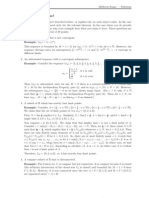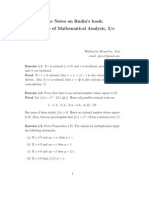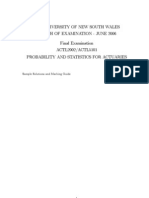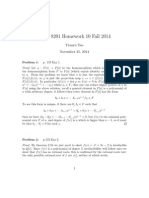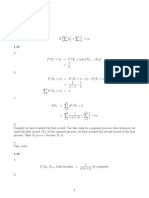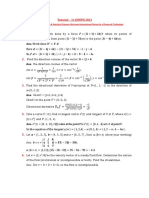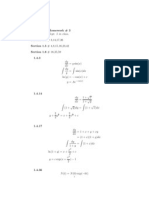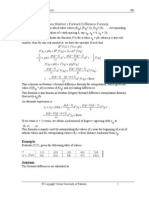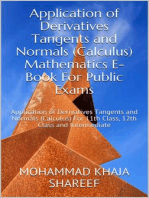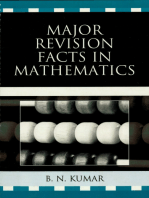0 ratings0% found this document useful (0 votes)
3K viewsMC0074 - Set 2
MC0074 - Set 2
Uploaded by
nikeneelThis document contains 6 questions and answers related to statistical and numerical methods using C++. It includes questions on:
1) Explaining the concept of a Bernoulli process and its properties.
2) Calculating absolute and relative error when approximating a value.
3) Writing a C++ program to add two matrices.
4) Finding a real root of a cubic equation using the bisection method.
5) Finding a cubic polynomial that satisfies given values.
6) Evaluating an integral using the trapezoidal rule to determine the value of π.
Copyright:
Attribution Non-Commercial (BY-NC)
Available Formats
Download as DOCX, PDF, TXT or read online from Scribd
MC0074 - Set 2
MC0074 - Set 2
Uploaded by
nikeneel0 ratings0% found this document useful (0 votes)
3K views4 pagesThis document contains 6 questions and answers related to statistical and numerical methods using C++. It includes questions on:
1) Explaining the concept of a Bernoulli process and its properties.
2) Calculating absolute and relative error when approximating a value.
3) Writing a C++ program to add two matrices.
4) Finding a real root of a cubic equation using the bisection method.
5) Finding a cubic polynomial that satisfies given values.
6) Evaluating an integral using the trapezoidal rule to determine the value of π.
Copyright
© Attribution Non-Commercial (BY-NC)
Available Formats
DOCX, PDF, TXT or read online from Scribd
Share this document
Did you find this document useful?
Is this content inappropriate?
This document contains 6 questions and answers related to statistical and numerical methods using C++. It includes questions on:
1) Explaining the concept of a Bernoulli process and its properties.
2) Calculating absolute and relative error when approximating a value.
3) Writing a C++ program to add two matrices.
4) Finding a real root of a cubic equation using the bisection method.
5) Finding a cubic polynomial that satisfies given values.
6) Evaluating an integral using the trapezoidal rule to determine the value of π.
Copyright:
Attribution Non-Commercial (BY-NC)
Available Formats
Download as DOCX, PDF, TXT or read online from Scribd
Download as docx, pdf, or txt
0 ratings0% found this document useful (0 votes)
3K views4 pagesMC0074 - Set 2
MC0074 - Set 2
Uploaded by
nikeneelThis document contains 6 questions and answers related to statistical and numerical methods using C++. It includes questions on:
1) Explaining the concept of a Bernoulli process and its properties.
2) Calculating absolute and relative error when approximating a value.
3) Writing a C++ program to add two matrices.
4) Finding a real root of a cubic equation using the bisection method.
5) Finding a cubic polynomial that satisfies given values.
6) Evaluating an integral using the trapezoidal rule to determine the value of π.
Copyright:
Attribution Non-Commercial (BY-NC)
Available Formats
Download as DOCX, PDF, TXT or read online from Scribd
Download as docx, pdf, or txt
You are on page 1of 4
February 2010
Master of Computer Application (MCA) – Semester 3
MC0074 – Statistical & Numerical Methods using C++
Assignment Set – 2
1. Briefly explain the concept of Bernoulli’s process
Ans –
The Bernoulli Process
Consider a sequence of independent Bernoulli trials and let the discrete random variable
Yi denote the result of the ith trial, so that the event [Yi =1] denotes a success on the ith
trial and the event[Yi = 0] denotes a failure on the ith trial. Further assume that the
probability of success on the ith trial, P[Yi = 1], is p, which is independent of the index i.
then {Yi|i=1,2…n} is a discrete state, discrete parameter, stochastic process, which is
stationary in the strict sence. Since the Yi’s are mutually independent, the above process
is an independent process known as the Bernoulli process. Since Yi is a Bernoulli random
variable, we recall that
E[Yi] = p
E[Yi2] = p
Var[Yi] = p(1-p)
and GYi(z) = (1-p)+pz
based on the Bernoulli process, we may form another stochastic process by considering
the sequence of partial sums{Sn|n=1,2…}, where Sn=Y1+Y2+…+Yn. by rewriting Sn=Sn-
1+Yn, it is not difficult to see that {Sn} is a discrete state, discrete parameter Markov
process, since
P(Sn =k|Sn-1 = K) = P(Yn=0)
1-p
And
P(Sn=K|Sn-1 = K-1) = P(Yn =1)
=p
Clearly
P(Sn=K) = (n) pk(1-p)n-k
= (k)
E[Sn]=np
Var[Sn]=np(1-p)
and
GSn(z) = (1-p+pz)n
Define the discrete random variable T1, called the first order interarrival time, to be the
number of trials up to and including the first success.
T1 is geometrically distributed so that
P(Ti=i) = p(1-p)i-1, i=1,2…
E(T1)=1/p
Var(T1) = 1-p/p2
and
[G T1(z) = zp/1-z(1-p)]
Similarly
[G Tr(z) =[ zp/1-z(1-p)]r]
2. If is approximated by 0.667, find the absolute
2
3
and relative errors
Ans –
absolute error = 0.001666666...
relative error = 0.0024999 approx
3. Write a program in C++ language for the addition
of two matrices.
Ans –
#include<iostream.h>
#include<conio.h>
void main()
{ int ch,a[10][10],b[10][10],c[10][10],m,n,o,p,i,j;
clrscr();
cout<<"Enter row no. and column no. of matrix 1: ";cin>>m>>n;
cout<<"Enter row no. and column no. of matrix 2: ";cin>>o>>p;
if (m!=o||n!=p) cout<<"Matrix cannot be added";
else
{ cout<<"\nEnter elements of matrix 1..\n";
for (i=0;i<m;i++) for (j=0;j<n;j++) cin>>a[i][j];
cout<<"\nEnter elements of matrix 2..\n";
for (i=0;i<o;i++) for (j=0;j<p;j++) cin>>b[i][j];
for (i=0;i<m;i++)
for (j=0;j<n;j++) c[i][j]=a[i][j]+b[i][j];
cout<<"\nMatrix after addition..\n";
for (i=0;i<m;i++)
{ for (j=0;j<n;j++) cout<<c[i][j]<<" ";
cout<<"\n";
}
}
}
}
4. Find a real root of the equation x3 – 4x – 9 = 0
using the bisection method
Ans –
First Let x0 be 1 and x1 be 3
F(x0) = x3 – 4x -9
=1–4–9
= -12 < 0
F(x1) =27 – 12 – 9
=6>0
Therefore, the root lies between 1 and 3
Now we try with x2 =2
F(x2) = 8 – 8 – 9
= -9 < 0
Therefore, the root lies between 2 and 3
X3 = (x1+x2)/2
=(3+2)/2
= 2.5
F(x3) = 15.625 – 10 – 9
= - 3.375 < 0
Therefore, the root lies between 2.5 and 3
X4 = (x1+x3)/2
= 2.75
5. Find the cubic polynomial which takes the
following values y(0) = 1, y(1) = 0, y(2) = 1 and y(3) =
10 . Hence obtain the value of y(0.5).
Ans –
y(x) = 1 - 2 x2 + x3
Check:
y(0) = 1, y(1) = 0, y(2) = 1 and y(3) = 10
y(0.5) = 0.625
6. Evaluate using Trapezoidal rule with h = 0.2.
1
dx
∫ 1 + x2
0
Hence determine the value of π.
Ans-
0.7837,3.1349
You might also like
- 4 SolDocument6 pages4 Solnaman100% (2)
- MC0074 - Statistical and Numerical Methods Using C++Document14 pagesMC0074 - Statistical and Numerical Methods Using C++Ravish RavindranNo ratings yet
- STAT 333 Assignment 1 SolutionsDocument6 pagesSTAT 333 Assignment 1 SolutionsliquidblackoutNo ratings yet
- Solutions Manual To: An Introduction To Mathematical Finance: Options and Other TopicsDocument65 pagesSolutions Manual To: An Introduction To Mathematical Finance: Options and Other TopicsHanh VuNo ratings yet
- Bernoulli DistributionDocument28 pagesBernoulli DistributionDeepakNo ratings yet
- DSP 1Document129 pagesDSP 1Asif Eakball EmonNo ratings yet
- hw3 SolDocument8 pageshw3 SolanthalyaNo ratings yet
- Selected Probability Models: Bernoulli Trials - Most Common Type of Situation ModeledDocument6 pagesSelected Probability Models: Bernoulli Trials - Most Common Type of Situation ModeledLibyaFlowerNo ratings yet
- International Competition in Mathematics For Universtiy Students in Plovdiv, Bulgaria 1995Document11 pagesInternational Competition in Mathematics For Universtiy Students in Plovdiv, Bulgaria 1995Phúc Hảo ĐỗNo ratings yet
- Abstract Algebra SolutionsDocument141 pagesAbstract Algebra SolutionsThigpen Fockspace88% (8)
- 11.1: Taylor Polynomials The Derivative As The First Taylor PolynomialDocument7 pages11.1: Taylor Polynomials The Derivative As The First Taylor PolynomialNguyên BùiNo ratings yet
- Detailed Solutions A-07 JUNE 2003: I X X F F IDocument32 pagesDetailed Solutions A-07 JUNE 2003: I X X F F IAdzLinkBalaoangNo ratings yet
- Math 110: Linear Algebra Practice Final SolutionsDocument7 pagesMath 110: Linear Algebra Practice Final SolutionsCody SageNo ratings yet
- Real Counterexample.Document10 pagesReal Counterexample.mandilipNo ratings yet
- E (Return) (1/2) 2 (7/2) + 1/2 (1/2) (7/2), Where 7/2 Is Expect Value of A Die, (5/4) (7/2)Document4 pagesE (Return) (1/2) 2 (7/2) + 1/2 (1/2) (7/2), Where 7/2 Is Expect Value of A Die, (5/4) (7/2)jeannteNo ratings yet
- SolutionManual August29Document36 pagesSolutionManual August29kwontae97No ratings yet
- MidSem11 Alt SolDocument5 pagesMidSem11 Alt SolsacredgamesNo ratings yet
- Problem Set 5: N 2 N N 2 NDocument6 pagesProblem Set 5: N 2 N N 2 NanthalyaNo ratings yet
- Assignment #1 Solution: N N 1 N 1 NDocument6 pagesAssignment #1 Solution: N N 1 N 1 NAdil AliNo ratings yet
- Principles of Mathematical Analysis Rudin SolutionsDocument99 pagesPrinciples of Mathematical Analysis Rudin Solutionstimcantango100% (6)
- Markov Chains: 4.1 Stochastic ProcessesDocument42 pagesMarkov Chains: 4.1 Stochastic ProcessesDimas AdipNo ratings yet
- Problems by Jim Pitman. Solutions by George ChenDocument8 pagesProblems by Jim Pitman. Solutions by George ChenspitzersglareNo ratings yet
- Actl 20025101 Finalexamsolutions 2006Document15 pagesActl 20025101 Finalexamsolutions 2006柯颖No ratings yet
- Counting Methods and The Pigeonhole PrincipleDocument23 pagesCounting Methods and The Pigeonhole PrincipleMohammad Gulam AhamadNo ratings yet
- CH2. Locating Roots of Nonlinear EquationsDocument17 pagesCH2. Locating Roots of Nonlinear Equationsbytebuilder25No ratings yet
- HPI-6 Coordinate Geometry & IntegralDocument18 pagesHPI-6 Coordinate Geometry & Integralusaha779No ratings yet
- Math 8201 Homework 10 Fall 2014: Tianyu Tao November 25, 2014Document5 pagesMath 8201 Homework 10 Fall 2014: Tianyu Tao November 25, 2014Tianyu TaoNo ratings yet
- Optimal Binary Search TREES (Contd..) : P (K) +COST (L) +COST (R) +W (0, k-1) +W (K, N) .....Document55 pagesOptimal Binary Search TREES (Contd..) : P (K) +COST (L) +COST (R) +W (0, k-1) +W (K, N) .....Slim ShadyNo ratings yet
- SolutionsDocument77 pagesSolutionsramon314dNo ratings yet
- G 12 Man OptionalDocument13 pagesG 12 Man Optionalwill2222No ratings yet
- P P (Red Ball) 3/5, Which Remains Constant From Trial To TrialDocument10 pagesP P (Red Ball) 3/5, Which Remains Constant From Trial To Trialrohitrgt4uNo ratings yet
- 数学分析习题课讲义(复旦大学 PDFDocument88 pages数学分析习题课讲义(复旦大学 PDFradioheadddddNo ratings yet
- EECS50 Midterm 1 S16Document7 pagesEECS50 Midterm 1 S16FUSIONNo ratings yet
- Matlab I N Section21Document13 pagesMatlab I N Section2112 Dhanya ShriNo ratings yet
- Ws1 - Probability Generating FunctionssolDocument12 pagesWs1 - Probability Generating FunctionssolkelerongNo ratings yet
- SMO 2010 Open SolutionDocument11 pagesSMO 2010 Open SolutionwmdsgNo ratings yet
- Pgdca-123 ConamDocument10 pagesPgdca-123 Conamrajendrarajpurohit19No ratings yet
- Practice Problems SolutionsDocument5 pagesPractice Problems SolutionsBatchb689No ratings yet
- ch4 - Counting PrincipleDocument23 pagesch4 - Counting PrincipleMohammad Gulam AhamadNo ratings yet
- MATH3705 Tutorial 3: Solution: We Rewrite The Equation AsDocument3 pagesMATH3705 Tutorial 3: Solution: We Rewrite The Equation AsminyounNo ratings yet
- EMTH202-Tutorial 11 With Solution-Week 11Document2 pagesEMTH202-Tutorial 11 With Solution-Week 11Olebile Thap2No ratings yet
- comp106_5_induction_and_recursionDocument31 pagescomp106_5_induction_and_recursionBEYZA ÇAVUŞOĞLUNo ratings yet
- hw3 SolnDocument5 pageshw3 SolnIlham SaputraNo ratings yet
- Probability 2 NotesDocument5 pagesProbability 2 NotesEXAMMATENo ratings yet
- Numerical Analysis - MTH603 Handouts Lecture 21Document5 pagesNumerical Analysis - MTH603 Handouts Lecture 21roshanpateliaNo ratings yet
- Ans8 1Document2 pagesAns8 1Cyril ChukwunyemNo ratings yet
- Theoretical Computer Science Cheat SheetDocument10 pagesTheoretical Computer Science Cheat SheetRosa GonzalezNo ratings yet
- Introduction To Real Analysis Fall 2014 Lecture Notes: Vern I. Paulsen November 6, 2014Document81 pagesIntroduction To Real Analysis Fall 2014 Lecture Notes: Vern I. Paulsen November 6, 2014Ask Bulls BearNo ratings yet
- Lab 4Document6 pagesLab 4Kharolina BautistaNo ratings yet
- Answer: (A) PR (BDocument14 pagesAnswer: (A) PR (BMohitNo ratings yet
- De Moiver's Theorem (Trigonometry) Mathematics Question BankFrom EverandDe Moiver's Theorem (Trigonometry) Mathematics Question BankNo ratings yet
- Trigonometric Ratios to Transformations (Trigonometry) Mathematics E-Book For Public ExamsFrom EverandTrigonometric Ratios to Transformations (Trigonometry) Mathematics E-Book For Public ExamsRating: 5 out of 5 stars5/5 (1)
- Mathematics 1St First Order Linear Differential Equations 2Nd Second Order Linear Differential Equations Laplace Fourier Bessel MathematicsFrom EverandMathematics 1St First Order Linear Differential Equations 2Nd Second Order Linear Differential Equations Laplace Fourier Bessel MathematicsNo ratings yet
- Application of Derivatives Tangents and Normals (Calculus) Mathematics E-Book For Public ExamsFrom EverandApplication of Derivatives Tangents and Normals (Calculus) Mathematics E-Book For Public ExamsRating: 5 out of 5 stars5/5 (1)
- Analytic Geometry: Graphic Solutions Using Matlab LanguageFrom EverandAnalytic Geometry: Graphic Solutions Using Matlab LanguageNo ratings yet














